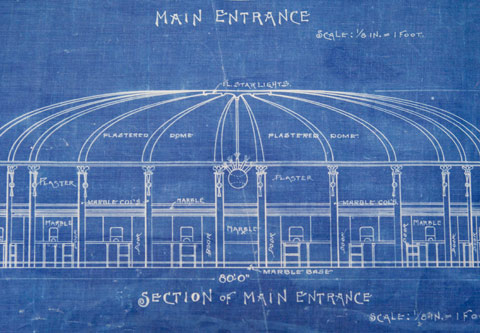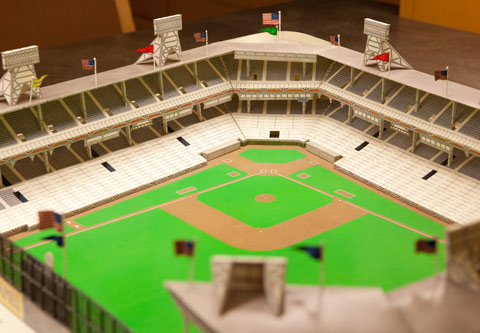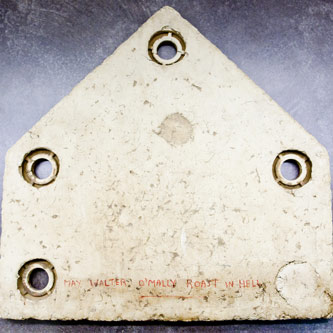Memorabilia From Ebbets Field Stir Memories of Glory Days of Brooklyn Dodger Baseball
May 7, 2012

Blueprint of the main entrance to Ebbets Field, filed in 1912 by Dodgers president Charles H. Ebbets and architect Clarence R. Van Buskirk.
Major League Baseball has been absent from Brooklyn for 55 years. That's how long ago it was when Dodgers owner Walter O'Malley unceremoniously uprooted the beloved team from its Ebbets Field home in Flatbush and transplanted "dem Bums" to the dusty environs of Chavez Ravine outside Los Angeles. The move left Brooklyn Dodger fans with the bitter taste of betrayal in their mouths and earned the O'Malley family a seemingly unending stream of heated invective to this day.
An exhibit of Ebbets Field memorabilia at the Brooklyn College Library is intended to explore the deep love that Brooklyn baseball fans had for the Dodgers, and to explain the residual ill feeling that still adds heat to any discussion of Brooklyn baseball.
Brooklyn borough historian Ron Schweiger '70 donated numerous collectibles from the Dodgers' time in Ebbets Field to the display. "I collect everything Brooklyn," he says.
He kicked off the exhibit with a talk titled "There Used to Be a Ballpark: Ebbets Field and the Dodgers." Schweiger told of the construction of Ebbets Field, of the illustrious members of the teams who played there and of the ballpark's sorry end.
Officially called the Brooklyn Base Ball Club, the Dodgers had been in existence since the 1880s. The team had played baseball under a number of nicknames, including the Bridegrooms, the Robins and the Superbas. But the one name that stuck was "Dodgers."
According to Schweiger, the name was derived from the expression "trolley dodgers" — a pejorative term coined by the residents of Manhattan to describe the baseball-loving inhabitants of Brooklyn, who had to dodge across busy trolley tracks to reach local ballgames. "It was an early version of ‘bridge-and-tunnel' people," he notes.

Model shows Ebbets Field as it was during the heyday of Brooklyn Dodgers baseball.
Over time, the "trolley" was dropped and the team became known simply as the Dodgers.
Highlighting the library's exhibit are three of 18 sheets of blueprints dating from 1912 show the classic lines of the ballpark as it was envisioned by then team president Charles Hercules Ebbets and architect Clarence R. Van Buskirk. The "bandbox"-style park, when it opened the following April, seated 18,000 fans. Over the years this number rose to 32,000.
Also on display is a model of the ballpark as well as one of the last home plates reported to have been found still in place inside Ebbets Field in 1960, when the ballpark was cleared for demolition.
Research, according to archivists, indicates the home plate was presented to former Brooklyn College President Robert L. Hess and displayed in his office in the 1980s. Its face has been crudely inscribed with the words "May Walter O'Mally (sic) Roast in Hell." This sentiment and other similar expressions of outrage were widely shared by Dodger fans following O'Malley's decision to move the Dodgers from Brooklyn to Los Angeles at the close of the 1957 season.
"We've had a lot of interest in this exhibit," says archivist Marianne LaBatto. "If the interest keeps on at the same level, we'll keep the exhibit up into the next academic year."

Showing signs of wear, this home plate from Ebbets Field bears the curse shared by many Brooklyn Dodgers fans: "May Walter O'Mally (sic) Roast in Hell."
Nestled within a single block of real estate bounded by Sullivan Place, McKeever Place, Montgomery Street and Bedford Avenue, Ebbets Field was home to a succession of teams manned and managed by giants. They included Roy Campanella, Duke Snyder, Leo Durocher, Branch Rickey and Peewee Reese.
Perhaps more significant than anything else in their history was the fact that after being signed to play with the Dodgers, Jackie Robinson, the first African-American baseball player in the major leagues, stepped onto Ebbets Field and desegregated the national pastime. That was more than a year before President Harry S. Truman desegregated the U.S. military.
While at Ebbets Field, the Dodgers won the National League pennant in 1916, 1920, 1941, 1947, 1949, 1952, 1953, 1955 and 1956. However, they succeeded in winning the World Series only once during those years — the 1955 season ender against their crosstown rivals, the New York Yankees.
Two years after their World Series win, the Dodgers could not find a larger home in the borough where they could expand. According to Schweiger, O'Malley had no choice but to move the team from Brooklyn.
In February 1960, a two-ton wrecking ball painted to look like a baseball began the demolition of Ebbets Field — though memories of that beloved sport palace still live in the minds and hearts of old-time baseball fans to this day.






